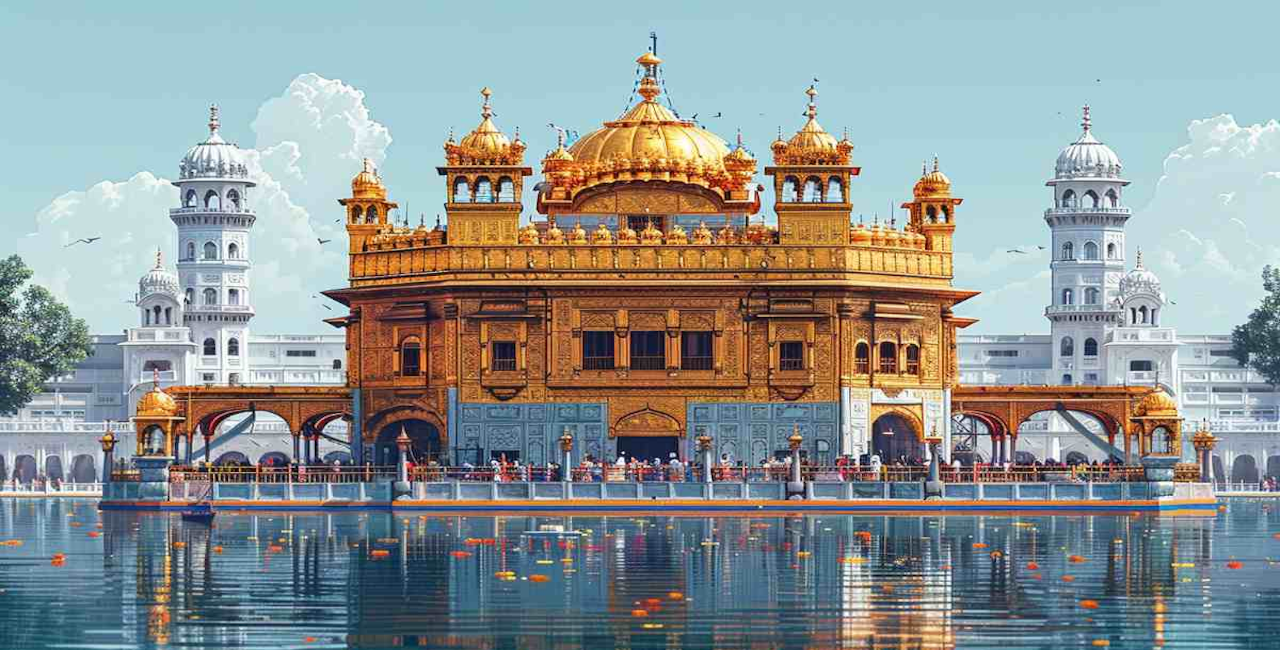Amritsar, a vibrant city in the northern state of Punjab, India, is steeped in history, spirituality, and cultural richness. Known as the heart of Sikhism, it attracts millions of visitors from around the world to its sacred shrines, bustling markets, and historical landmarks. Founded in 1577 by the fourth Sikh Guru, Guru Ram Das, Amritsar’s name is derived from “Amrit Sarovar,” meaning “Pool of Nectar,” which refers to the holy water tank surrounding the Golden Temple. Over the centuries, Amritsar has evolved into a symbol of Punjabi pride, spiritual devotion, and resilience.
The Golden Temple: A Symbol of Sikhism and Spirituality
The Golden Temple, also known as Harmandir Sahib, is the most iconic landmark in Amritsar and a revered place of worship for Sikhs worldwide. This stunning structure, with its gleaming golden dome and serene pool, is surrounded by the Amrit Sarovar, a body of holy water believed to have healing properties. The temple’s architecture is an exquisite blend of Hindu and Islamic styles, with an elegant marble lower level and a gold-plated upper level.
The temple is open to people of all faiths, embodying the Sikh principles of equality, humility, and inclusiveness. Visitors are drawn to its peaceful ambiance, where the sound of devotional music (kirtan) fills the air, creating an atmosphere of deep spirituality. The Guru Granth Sahib, the holy scripture of Sikhism, is kept inside the temple during the day, and every evening, it is taken to the Akal Takht in a grand procession, a sight cherished by devotees.
One of the most remarkable aspects of the Golden Temple is the Langar, or community kitchen, which serves free meals to thousands of people daily, regardless of their background. Volunteers prepare and serve simple, wholesome food as an act of seva (selfless service), reflecting the Sikh commitment to charity and unity. The Langar Hall, the world’s largest community kitchen, exemplifies the Sikh value of sharing and inclusivity.
Jallianwala Bagh: A Place of Remembrance and National Pride
A short walk from the Golden Temple, Jallianwala Bagh is a public garden that stands as a poignant reminder of India’s struggle for freedom. On April 13, 1919, British troops, led by General Dyer, opened fire on a peaceful gathering of unarmed civilians, resulting in a massacre that claimed hundreds of lives. The tragic event marked a turning point in India’s independence movement, stirring national outrage and strengthening the resolve for independence.
Today, Jallianwala Bagh is a well-preserved memorial with a Martyrs’ Gallery and an eternal flame that honors the victims. Bullet marks on the walls are visible, offering a stark reminder of the horrors that occurred here. For visitors, Jallianwala Bagh is a place of reflection, evoking a deep sense of respect for those who sacrificed their lives for India’s freedom.
Wagah Border: A Display of National Pride and Patriotism
Located about 30 kilometers from Amritsar, the Wagah Border is a major attraction for visitors to Punjab. It marks the boundary between India and Pakistan, and each evening, a ceremonial flag-lowering ceremony takes place here. Known as the Beating Retreat Ceremony, this event is a lively display of patriotism, featuring the synchronized marching of soldiers, elaborate salutes, and the enthusiastic cheering of crowds from both sides.
The atmosphere is electric, as spectators wave flags, sing patriotic songs, and chant slogans. The ceremony is a symbolic reminder of the complex relationship between India and Pakistan, blending tension with shared heritage. For many visitors, witnessing the Wagah Border ceremony is a moving experience that instills a sense of national pride and unity.
Rich Culinary Heritage
Amritsar is a paradise for food lovers, offering a rich array of Punjabi delicacies that reflect the city’s culinary traditions. The city is famous for its Amritsari kulchas, stuffed flatbreads baked to perfection in a tandoor and served with tangy chole (chickpea curry). Makki di roti and sarson da saag, a combination of maize flatbread and mustard greens, are popular dishes that capture the essence of Punjabi cuisine.
In the bylanes near the Golden Temple, visitors can savor street foods like chaat, golgappas, and lassi, a refreshing yogurt-based drink often served in tall steel glasses. Amritsar’s food culture is deeply rooted in community and hospitality, with eateries like Kesar Da Dhaba serving traditional dishes in a humble setting. Food tours around the city provide a delightful experience of local flavors and Punjabi warmth.
Vibrant Markets and Handicrafts
Amritsar is a lively shopping destination, known for its colorful markets and traditional handicrafts. Hall Bazaar, one of the oldest markets, is a bustling spot where you can find a variety of items, including textiles, jewelry, handicrafts, and electronics. Amritsar is famous for its Phulkari embroidery, a traditional Punjabi art form characterized by vibrant floral designs stitched on fabric, often used in dupattas, sarees, and shawls.
Another popular market is Guru Bazaar, which specializes in gold and silver jewelry. Tourists can also find juttis (Punjabi footwear), intricate carpets, and Punjabi suits that reflect the city’s rich cultural heritage. Shopping in Amritsar’s markets is a sensory delight, with the aroma of spices, the vibrant colors of traditional attire, and the sounds of lively bargaining filling the air.
Conclusion
Amritsar is a city of deep spiritual roots, rich history, and dynamic culture. From the tranquility of the Golden Temple to the patriotism of the Wagah Border and the poignant memories at Jallianwala Bagh, Amritsar offers an experience that is both uplifting and humbling. It is a place where history, spirituality, and Punjabi hospitality converge, creating a unique cultural tapestry. For anyone seeking to understand the essence of Punjab and the spirit of Sikhism, Amritsar stands as a remarkable destination that leaves an indelible impression.


0 Comment